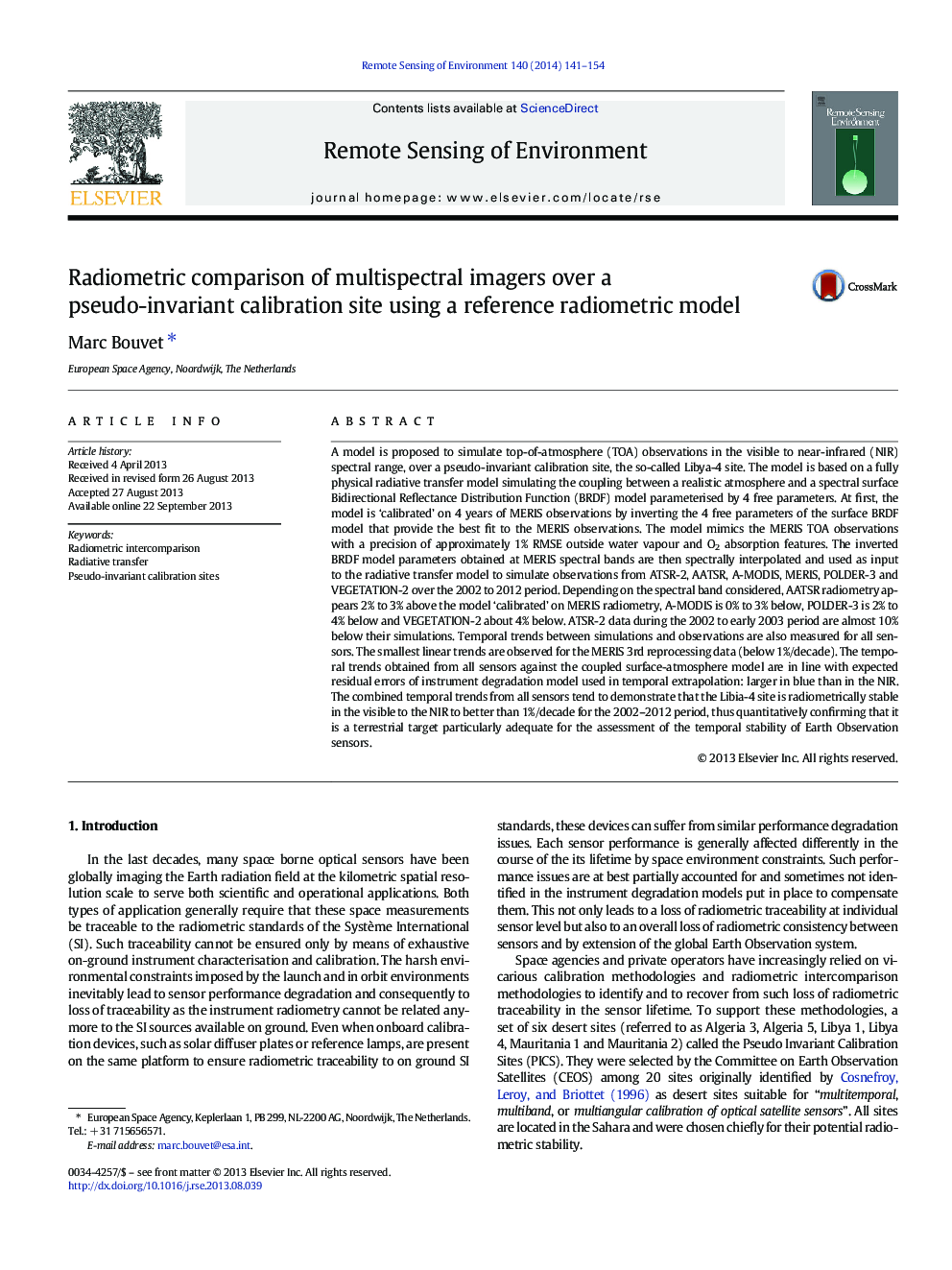| کد مقاله | کد نشریه | سال انتشار | مقاله انگلیسی | نسخه تمام متن |
|---|---|---|---|---|
| 6346976 | 1621260 | 2014 | 14 صفحه PDF | دانلود رایگان |
عنوان انگلیسی مقاله ISI
Radiometric comparison of multispectral imagers over a pseudo-invariant calibration site using a reference radiometric model
ترجمه فارسی عنوان
مقایسه رادیومتریک تصویرگرهای چندرسانه ای در یک سایت کالیبراسیون شبه غیرانسانی با استفاده از یک مدل رادیومتری مرجع
دانلود مقاله + سفارش ترجمه
دانلود مقاله ISI انگلیسی
رایگان برای ایرانیان
کلمات کلیدی
تعادل رادیومتریک، انتقال شعاعی، سایت های کالیبراسیون شبه غیرانسانی،
موضوعات مرتبط
مهندسی و علوم پایه
علوم زمین و سیارات
کامپیوتر در علوم زمین
چکیده انگلیسی
A model is proposed to simulate top-of-atmosphere (TOA) observations in the visible to near-infrared (NIR) spectral range, over a pseudo-invariant calibration site, the so-called Libya-4 site. The model is based on a fully physical radiative transfer model simulating the coupling between a realistic atmosphere and a spectral surface Bidirectional Reflectance Distribution Function (BRDF) model parameterised by 4 free parameters. At first, the model is 'calibrated' on 4Â years of MERIS observations by inverting the 4 free parameters of the surface BRDF model that provide the best fit to the MERIS observations. The model mimics the MERIS TOA observations with a precision of approximately 1% RMSE outside water vapour and O2 absorption features. The inverted BRDF model parameters obtained at MERIS spectral bands are then spectrally interpolated and used as input to the radiative transfer model to simulate observations from ATSR-2, AATSR, A-MODIS, MERIS, POLDER-3 and VEGETATION-2 over the 2002 to 2012 period. Depending on the spectral band considered, AATSR radiometry appears 2% to 3% above the model 'calibrated' on MERIS radiometry, A-MODIS is 0% to 3% below, POLDER-3 is 2% to 4% below and VEGETATION-2 about 4% below. ATSR-2 data during the 2002 to early 2003 period are almost 10% below their simulations. Temporal trends between simulations and observations are also measured for all sensors. The smallest linear trends are observed for the MERIS 3rd reprocessing data (below 1%/decade). The temporal trends obtained from all sensors against the coupled surface-atmosphere model are in line with expected residual errors of instrument degradation model used in temporal extrapolation: larger in blue than in the NIR. The combined temporal trends from all sensors tend to demonstrate that the Libia-4 site is radiometrically stable in the visible to the NIR to better than 1%/decade for the 2002-2012 period, thus quantitatively confirming that it is a terrestrial target particularly adequate for the assessment of the temporal stability of Earth Observation sensors.
ناشر
Database: Elsevier - ScienceDirect (ساینس دایرکت)
Journal: Remote Sensing of Environment - Volume 140, January 2014, Pages 141-154
Journal: Remote Sensing of Environment - Volume 140, January 2014, Pages 141-154
نویسندگان
Marc Bouvet,
